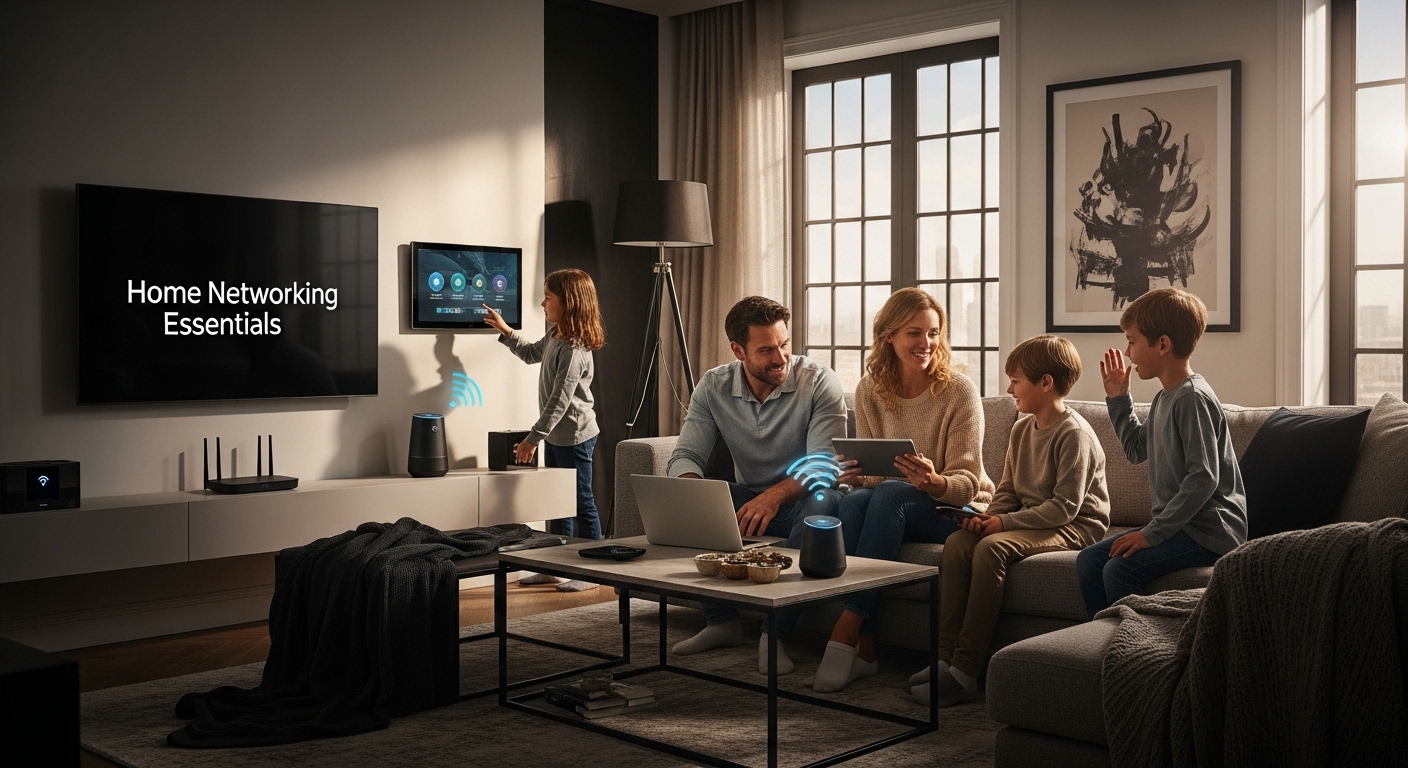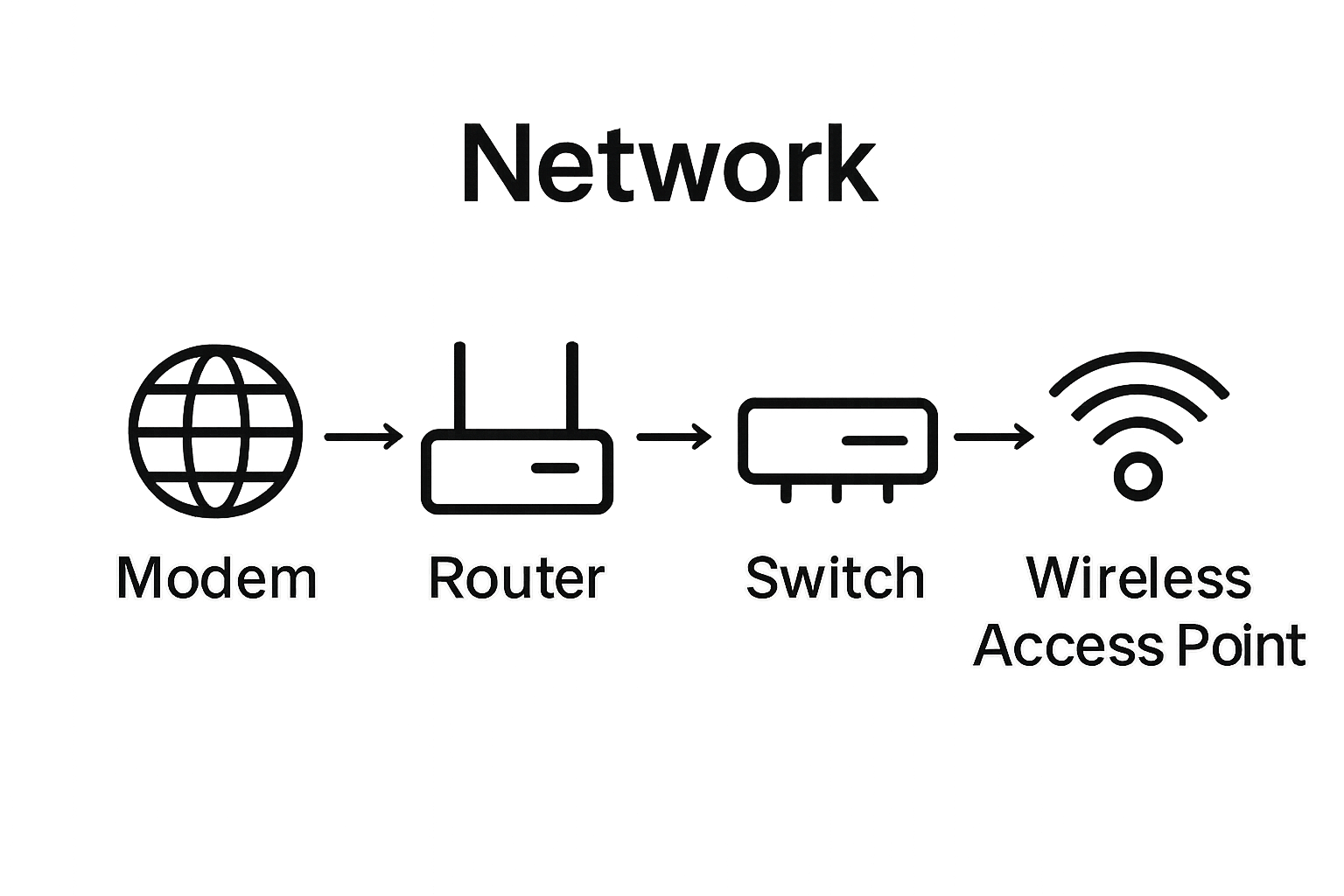Understanding Home Networking Essentials for Luxury Living
- garygarihanjr
- Sep 12
- 8 min read

Home networking shapes how our houses come alive with technology, connecting everything from smartphones to smart fridges. Most people think of it as just a way to get faster Wi-Fi or stream Netflix without buffering. Yet the real power sits deeper. Advanced home networks can synchronize your entire entertainment system across every room and even predict your preferences using artificial intelligence, turning your house into a responsive living experience.
Table of Contents
Quick Summary
Takeaway | Explanation |
Home networks enhance digital living. | They create an integrated environment for devices, improving connectivity and efficiency. |
Smart devices bring intelligence. | These devices collect data and learn user preferences to optimize home automation and convenience. |
Advanced security protocols are crucial. | Strong security measures protect user data and ensure privacy in connected environments. |
Future networks will be self-optimizing. | Next-gen networks will anticipate needs through AI, making home management seamless and intuitive. |
Luxury living demands strategic network design. | High-end homes require planning for bandwidth and device compatibility to support sophisticated technologies. |
What is Home Networking and Why It Matters
Home networking represents the digital infrastructure that connects various devices, systems, and technologies within a residential environment, transforming how we interact with our living spaces. Research from the National Center for Biotechnology Information reveals that home networking is the foundational framework enabling intelligent services and seamless device integration.
The Core Architecture of Home Networks
At its essence, home networking involves creating a comprehensive communication system that allows different technological components to interact, share data, and function cohesively. This interconnected ecosystem encompasses everything from smartphones and computers to smart appliances, security systems, and entertainment platforms. The primary goal is to create a unified, responsive environment that enhances convenience, efficiency, and user experience.
Key components of a robust home network typically include:
Routers: Central hubs that manage data transmission between devices
Ethernet and Wi-Fi connections: Physical and wireless data transfer mechanisms
Network switches: Devices that expand connection possibilities
Network security protocols: Systems protecting data integrity and privacy
The Transformative Impact of Advanced Home Networking
Modern home networking goes beyond simple internet connectivity. It enables sophisticated automation, real-time monitoring, and intelligent decision making within residential environments. Learn more about our guide to smart home installation to understand how these systems are implemented.
Advanced home networks provide homeowners with unprecedented control and insight. They can remotely manage security systems, adjust climate controls, monitor energy consumption, and create personalized entertainment experiences—all from a single interface. The integration of artificial intelligence and machine learning further enhances these capabilities, allowing networks to anticipate user preferences and optimize performance automatically.
For luxury living environments, home networking is not just a technological feature but a fundamental lifestyle enhancement that combines convenience, security, and personalized technological experiences.
Key Components of a Home Network: Understanding the Basics
Home networks function like intricate technological ecosystems, with multiple interconnected devices communicating seamlessly to deliver digital experiences. According to research from the University of Maryland’s Digital Literacy program, understanding these components is critical for creating reliable and efficient residential technology infrastructures.
The Essential Network Infrastructure
A comprehensive home network comprises several fundamental components that work together to enable communication, data transfer, and digital interactions. These core elements transform simple internet connectivity into a sophisticated technological environment.
The primary components of a robust home network include:

Modem: The gateway device that connects your home network to external internet services
Router: Central hub managing data transmission and network distribution
Network switches: Devices expanding connection possibilities and managing multiple device interactions
Wireless access points: Extending network coverage across larger residential spaces
Advanced Networking Considerations
Beyond basic connectivity, modern home networks require strategic planning and intelligent design. Explore our comprehensive guide to whole home audio systems to understand how sophisticated networking supports integrated technological experiences.
Professional home network design considers factors like bandwidth requirements, device compatibility, security protocols, and potential future expansion.
Luxury living environments demand networks that can simultaneously support high-bandwidth activities such as 4K video streaming, online gaming, smart home automation, and professional video conferencing without performance degradation.
Understanding these components allows homeowners to create responsive, secure, and adaptable digital environments that enhance convenience, entertainment, and overall technological integration.
The following table summarizes the primary components found in modern home networks and their main functions, helping clarify key roles in the overall ecosystem.
Component | Function |
Modem | Connects home network to external internet services |
Router | Manages data transmission and network distribution |
Network switches | Expands connection options, manages multiple devices |
Wireless access points | Extends network coverage throughout the home |
Security protocols | Protect data integrity and ensure network privacy |
The Role of Smart Devices in Home Networking
Smart devices represent the revolutionary frontier of home networking, transforming residential environments from static spaces into dynamic, interconnected technological ecosystems. According to research from the National Institute of Standards and Technology, these intelligent devices are fundamentally reshaping how we interact with our living spaces.
The Intelligent Device Ecosystem
Smart devices are sophisticated technological components that communicate, collect data, and respond to user preferences with unprecedented precision. These devices range from intelligent thermostats and security systems to advanced entertainment platforms and kitchen appliances. The defining characteristic of smart devices is their ability to collect, analyze, and act on data in real time.
Key smart device categories in modern home networks include:
Home automation devices: Control systems managing lighting, climate, and security
Entertainment systems: Smart TVs, audio equipment, and streaming devices
Personal assistants: Voice activated AI platforms controlling multiple home functions
Health and wellness monitors: Wearable technologies and fitness tracking systems
Network Integration and Intelligent Interactions
Check out our guide on smart home troubleshooting steps to understand how these complex systems maintain optimal performance. Smart devices do not merely exist within a network they actively contribute to its intelligence and adaptability. They communicate through sophisticated protocols, sharing information and coordinating actions to create seamless user experiences.
In luxury living environments, smart devices transcend traditional functionality. They learn from user behaviors, anticipate needs, and create personalized technological experiences that adapt in real time. This level of integration transforms home networking from a technical infrastructure into an intelligent, responsive living system that enhances comfort, efficiency, and personal well being.
How Home Networking Enhances Luxury Entertainment Systems
Home networking transforms entertainment systems from isolated components into integrated, intelligent experiences, creating immersive technological environments that transcend traditional media consumption. Research from distributed systems networking experts demonstrates how sophisticated network architectures enable seamless multimedia interactions.
The Technological Symphony of Connected Entertainment
Modern luxury entertainment systems are far more than simple audio and video platforms. They represent complex, interconnected ecosystems where multiple devices communicate simultaneously, delivering personalized, high-fidelity experiences. Advanced home networking allows for synchronized multimedia experiences across different rooms and devices, enabling unprecedented control and customization.
Key capabilities of networked entertainment systems include:
Multi room audio video streaming: Synchronized content delivery across different spaces
Intelligent content recommendation: AI driven personalization based on viewing habits
Device interoperability: Seamless connection between smartphones, televisions, speakers, and streaming platforms
High bandwidth content delivery: Supporting 4K, 8K, and immersive audio experiences
Transforming Home Entertainment Experiences
Explore our guide showcasing inspiring custom home theater designs to understand the potential of integrated entertainment networks. Home networking elevates entertainment from passive consumption to interactive, intelligent experiences. Imagine walking into a room where your preferred music starts automatically, lighting adjusts to create the perfect ambiance, and content recommendations appear based on your mood and previous selections.
In luxury living environments, home networking turns entertainment systems into responsive, adaptive platforms that understand and anticipate user preferences. The result is a deeply personalized technological experience that seamlessly blends entertainment, comfort, and cutting edge innovation.
This table highlights and compares how advanced home networking transforms entertainment experiences within luxury living spaces across several key features.
Entertainment Feature | Role of Advanced Home Networking |
Multi-room audio/video streaming | Enables seamless and synchronized content across multiple rooms |
Intelligent content recommendation | Delivers personalized media suggestions based on user preferences |
Device interoperability | Connects smartphones, TVs, and speakers into one unified system |
High-bandwidth content delivery | Supports 4K, 8K, and immersive experiences without interruptions |
Personalized environmental control | Automates ambiance with lighting and music based on user routines |

Future Trends in Home Networking for Affluent Homeowners
Home networking is rapidly evolving from a technological convenience to an intelligent, predictive ecosystem, transforming how high-end residential environments interact with technology. Emerging research in smart home technologies indicates that future home networks will become increasingly autonomous, adaptive, and personalized.
The Intelligent Network Paradigm
Next generation home networking transcends traditional connectivity, moving towards proactive, self optimizing systems that anticipate and respond to resident needs. These advanced networks will leverage artificial intelligence, machine learning, and sophisticated sensor technologies to create living environments that dynamically adjust to individual preferences, lifestyle patterns, and environmental conditions.
Key emerging trends in home networking include:
Predictive artificial intelligence: Systems that learn and adapt to user behaviors
Quantum encrypted security protocols: Advanced protection against cyber threats
Sustainable energy management: Intelligent networks optimizing power consumption
Holographic and immersive communication interfaces: Beyond traditional screen based interactions
Designing the Future of Connected Living
Explore our comprehensive guide on smart home pros and future living strategies to understand the transformative potential of these technologies. Future home networks will function as comprehensive life management platforms, integrating health monitoring, security, entertainment, and personal productivity into seamless, intuitive experiences.
For affluent homeowners, these technological advancements represent more than mere convenience they symbolize a fundamental reimagining of residential living. Networks will become intelligent companions, understanding complex human contexts and providing personalized solutions that enhance comfort, efficiency, and overall quality of life.
Ready to Transform Your Home Networking Into a Seamless Luxury Experience?
Are you tired of unreliable connections or frustrated by smart devices that only work part of the time? If your dream is a home where every device responds instantly and every entertainment moment feels tailored to you, it all starts with expert-level networking. The article outlined how true integration demands more than strong Wi-Fi—it requires infrastructure that brings all your technology together, securely and effortlessly.

Now is the perfect time to move from understanding to action. See the difference our expertise can make by exploring technology-driven custom home theater designs and whole home audio solutions. Experience how flawless home networking empowers every aspect of luxury living. Visit Techology Experts today to set up a personal consultation and unlock a smarter, simpler, and truly luxurious home environment.
Frequently Asked Questions
What is home networking?
Home networking refers to the digital infrastructure that connects various devices and technologies in a residential environment, allowing them to communicate, share data, and function together seamlessly.
How do smart devices enhance home networking?
Smart devices improve home networking by collecting and analyzing data to provide personalized experiences. They communicate with each other, enabling automated systems for lighting, climate control, security, and entertainment.
What are the key components of a robust home network?
Key components of a home network include a modem, router, network switches, wireless access points, and security protocols. These elements work together to ensure efficient connectivity and data transfer across devices.
How can home networking improve entertainment experiences in luxury living?
Home networking enhances entertainment systems by enabling synchronized multimedia experiences across multiple devices and rooms, providing high-quality streaming and personalized content recommendations based on user preferences.
Recommended
Comments